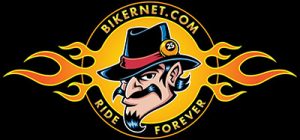
Each page reveals the history of the Black Hills motorcycle rally, over a 20 year period, during which Michael was sent to cover the event. Beyond the photo-journalist aspect, through the carefully scribed text, the personalities, the history and the riders’ feelings for the road, burst to life. It’s a tribute to all who have ever peeled through sizzling Avon tyres to reach the party in Sturgis. It’s a guide to anyone who has never attended a biker celebration of such magnitude or felt the exuberance and freedom of the open road.

The history, of Sturgis and the Badland, reaches way beyond the biker according to Michael, “Before outsiders came searching for precious metals, these Native Americans had a long and rich history, albeit not written. Acknowledging this, General William T. Sherman, representing the U.S. government, and Chief Red Cloud of the Oglala Sioux signed the Fort Laramie Treaty in 1868 to insure that the Native American way of life could continue as they knew it, uninterrupted. The following year, the treaty was ratified by the U.S. Senate and signed into law by President Andrew Johnson. According to the treaty, other than Indians, only U.S. government agents and the military were allowed into the area. Guaranteeing government protection of the Black Hills as a homeland for the Sioux, the treaty expressly prohibited trespassing by anyone else under penalty of removal and arrest.
“All seemed well until July 1874, when Colonel George Armstrong Custer led a 7th Cavalry expedition through the Black Hills to establish an army post and to see if rumors of gold were true…” You know the rest.

Motorcycle club life and style is revealed in the shots of brothers strolling down Main Street in Sturgis. “When I first got my “Property of” buckle, I hated it, “Donna said. “l wasn’t going to wear it, so it hung on the back of my chair for three weeks. I got the impression that this guy thought he owned me and controlled me, but I knew I was a single, independent woman and I wasn’t any body’s property. My man wasn’t happy. I didn’t understand that it meant more, to him, to give me that buckle than to give me a diamond ring. Eventually, I started getting to know more people and realized that if you wore the buckle, you were more respected by the brothers in the club. It also provides protection, to a certain degree, because people realize you are with a club and they leave you alone. I’ve been wearing my buckle for almost six years now. I feel naked without it. It’s a part of me and I wear it with pride.”

“Cowboys and bikers have always been connected in my mind, ” Michael professed in one of his captions. “What you see is the full frame, from edge to edge, as canted or cocked as it was in the viewfinder,” Michael added about his images. “While it would be easy to move or eliminate elements to improve a photograph, I have chosen to show it, as it is, or not show it at all.

If a picture is worth a thousand words this book is worthy of 165,000 at the bare minimum, plus the quotes, Peter Fonda and Dave Nichols input and Michael’s impressions of his many years relishing each shutter-snap from the bed of a pickup, the seat of a sidecar, or in a downpour, as longe as it was taken in the Badlands. It’s more than a photo book, but a memorial to a leather clad and chromed lifestyle representing one of the last American freedoms–Ride Forever.
–Bandit


